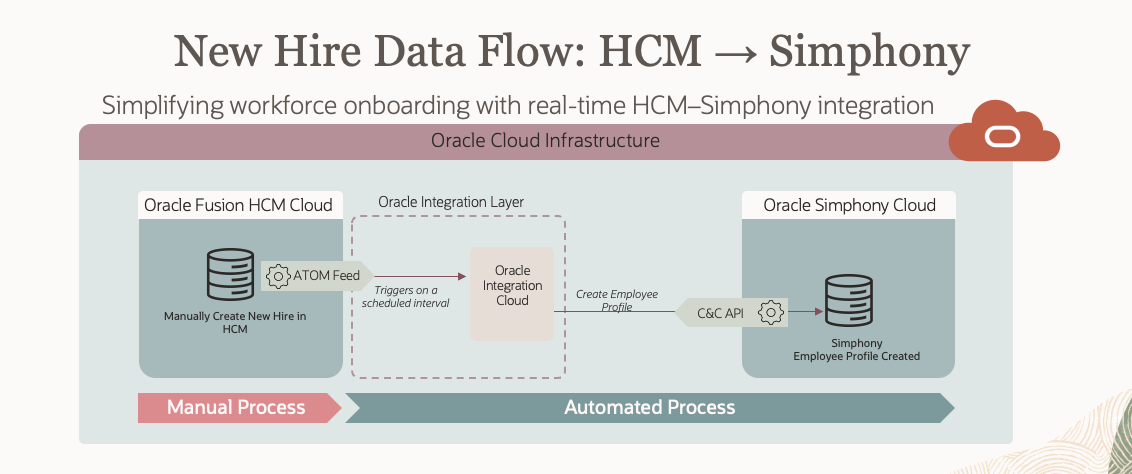In the hospitality and food and beverage industries, frequent staffing changes and the need to update multiple systems can create inefficiencies and errors. Oracle solves these challenges with Simphony, a robust cloud-based POS platform, and Fusion Cloud HCM, which centralizes HR and payroll functions. Through the integration of Oracle Fusion HCM and Simphony via Oracle Integration Cloud (OIC) on Oracle Cloud Infrastructure (OCI), large enterprises can onboard employees once and have their credentials and permissions automatically reflected in the POS system. This automation streamlines the entire provisioning process and reduces the risk of inconsistencies from manual and duplicate data entry.
Challenges with multiple systems:
In most hospitality and enterprise restaurant environments, HR teams manage employee lifecycle data in the HCM system, while operations teams manage POS access separately. This creates several challenges such as the following:
- Manually creating users across systems leads to inconsistency and inefficiency.
- Managing multiple user directories creates high IT overhead.
- Maintaining synchronized user roles and permissions is difficult. Delayed terminations in POS systems can create security concerns.
Oracle’s Advantage
Oracle is one of the few technology providers that:
- Owns both enterprise-grade platforms built for global operations—Oracle Fusion HCM and Oracle Simphony POS.
- Owns a cloud service, Oracle Integration Cloud, that can connect any application or data source to automate end-to-end processes and centralize management.
- Owns cloud infrastructure services engineered for mission-critical workloads with robust integration, automation, and security to unify systems – Oracle Cloud Infrastructure (OCI).
- Brings together dedicated industry, product, engineering, and field teams to deliver seamless, end-to-end solutions that surpass market expectations.
Oracle Integration Cloud (OIC) on Oracle Cloud Infrastructure (OCI) delivers custom integrations that:
- Exceed market expectations in speed, scalability, and reliability
- Enable real-time provisioning from a single source of truth
- Enforce role-based access control seamlessly across platforms
- Ensure instant, secure de-provisioning upon termination
- Scale effortlessly for seasonal, event-driven, or franchise-wide hiring
Oracle owns both the applications and the cloud, delivering solutions other providers can’t match.
Why Is Oracle Integration Cloud (OIC) important?
In today’s competitive environment, businesses need more than system connections; they need intelligent automation. Oracle Integration Cloud (OIC) is the platform that bridges applications like Fusion HCM and Simphony, automating HR processes from onboarding to offboarding. OIC ensures data consistency, reduces manual effort, and supports future growth with no custom coding required. With native AI integration, robotic process automation (RPA), and pre-built connectors for third-party systems, OIC empowers organizations to embed intelligence into workflows and stay agile in a rapidly changing market.
- Unified Operations: OIC integrates core systems like Fusion HCM and Simphony to remove data silos and streamline workflows.
- Automation for Efficiency: OIC automate critical HR processes of new hire provisioning and role changes. eliminating duplicate data entry across departments and speeding up employee onboarding.
- Data Accuracy: OIC provides near-real-time data synchronization to eliminate inconsistencies and ensure compliance.
- Built for Growth: OIC’s scalable and flexible architecture supports easy expansion and adaptation to evolving business needs.
- Advanced Capabilities: OIC leverages AI, RPA, and other automation features to embed intelligence and drive innovation.
Design Overview & Data Flows
The Fusion HCM and Simphony integration uses OIC to seamlessly transfer employee data between systems. Fusion HCM pushes updates—including new hires, changes, and terminations—via REST APIs and ATOM feeds, while Simphony receives and processes this data through its Configuration and Content (C&C) APIs. The integration enforces business rules, manages errors automatically, and ensures accurate, reliable data flow for all key HR events.
Architecture Diagram

APIs and Services Leveraged:
Fusion HCM APIs: –
A key enabler of Fusion–Simphony integration is the Fusion HCM Adapter in Oracle Integration Cloud (OIC). This prebuilt adapter offers seamless, out-of-the-box connectivity to Oracle Fusion HCM, removing the need for custom APIs or complex coding.
- Invoking New HIRE ATOM Feed: –
Using the adapter, OIC listens to the New Hire Atom feed in Fusion HCM. This recipe is purpose-built to synchronize only new hire employee records, ensuring that every newly onboarded team member in Fusion HCM is automatically created in Simphony with the appropriate access, role, and location assignments.
While the current version focuses exclusively on new hire provisioning, it establishes the architectural blueprint for future enhancements—updates, role changes, and terminations—that will extend automation across the entire employee lifecycle.
This foundation showcases what’s possible when Fusion HCM, OIC, and Simphony operate as a unified ecosystem
- Getting Assignment Details – Role and Location: –
Integrating Fusion HCM with Simphony requires more than just basic employee data—it also needs details on role and location assignments. HCM provides this information – including role, job, and location – via the getAllAssignments API (or Worker REST API). OIC parses and transforms this data into Simphony’s required format, ensuring each employee is provisioned with the correct access rights and work location in Simphony.
Simphony APIs:
On the Simphony side, the built-in REST Adapter with a three-legged OAuth security policy ensures secure, authenticated integration calls. Various API endpoints are called to get current Simphony configuration and setup details, and to create new employees or update existing ones.
- Getting employee roles, classes, and organizational hierarchy – Various Simphony APIs are called to get details about those configurations. Mapping jobs and locations in HCM to roles and locations in Simphony is part of the integration automation.
- Creating Employees: – Part of the Simphony Configuration and Content API, the employees2 API creates new employee records in the Simphony POS system. It allows programmatic addition of details such as Employee ID, Name, Employee Role, Payroll Information (e.g., Payroll ID), and Location and Revenue Center Assignments.
Integration Orchestration:
The only prerequisite for the integration to successfully run, is keeping location references and role names consistent between Fusion HCM and Simphony.
The scheduler-based orchestration captures relevant employee data from Fusion HCM, maps fields from HCM to Simphony, and updates Simphony during employee creation. OIC manages data mapping and validation, ensuring consistent and accurate records across both systems.
Executing the Integration: –
After activation, the integration automatically processes the latest New Hire feed, seamlessly creating employee records in Simphony.
At this stage, the recipe is scoped specifically to new hire synchronization—it does not yet handle updates or changes to existing employees.
This deliberate focus allows organizations to achieve immediate value through faster onboarding and error-free provisioning, while demonstrating the art of the possible: a future-ready foundation that can evolve to include dynamic updates, promotions, transfers, and terminations through additional OIC orchestrations.
By automating the most critical first step—onboarding—this integration brings organizations one step closer to end-to-end workforce lifecycle automation.

Real world Scenarios:
- Seasonal New Hire – A resort hires 200 summer staff. As soon as HR enters them in Fusion HCM, OIC provisions them in Simphony with the correct roles, so they are ready for day-one operations.
- Role change – A server is promoted to supervisor. Updating their role in Fusion automatically updates their POS permissions in Simphony.
- Termination – A terminated employee’s POS credentials are instantly removed upon processing in HCM, ensuring no lingering access.
Beyond immediate operational gains, OIC delivers long-term strategic benefits, including: Seamless cross-application employee provisioning – one source of truth for employee data across HR and POS systems.
- Process Automation and IT efficiency – Reduces manual work, freeing teams to focus on higher-value initiatives.
- Consistency and scalability across brands and locations – ideal for multi-property or multi-brand operators.
- Auditability and compliance readiness – every provisioning and de-provisioning action is logged for security and compliance audits
This integration marks the beginning of a larger transformation. By starting with new hire synchronization, businesses can witness the tangible value of automation—speed, consistency, and accuracy—before expanding into a fully connected HR-to-operations landscape.
With Oracle Integration Cloud as the central nervous system, the same design pattern can easily extend to handle promotions, transfers, and offboarding.
Imagine a future where every personnel change in Fusion HCM automatically updates Simphony in real time—creating a truly autonomous workforce management experience powered by Oracle Cloud Infrastructure.
Conclusion
Connecting Oracle Fusion HCM and Oracle Simphony POS through OCI integration services enables seamless employee provisioning. The integration eliminates redundant data entry and operational overhead, closes security gaps caused by delayed terminations, and ensures employees have timely, appropriate access. Oracle’s unique role as both an application and cloud provider enables this seamless integration delivered by a single solution vendor.
Resources and Links:
Integration Accelerators and Recipes

